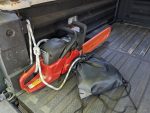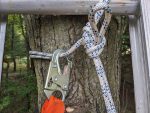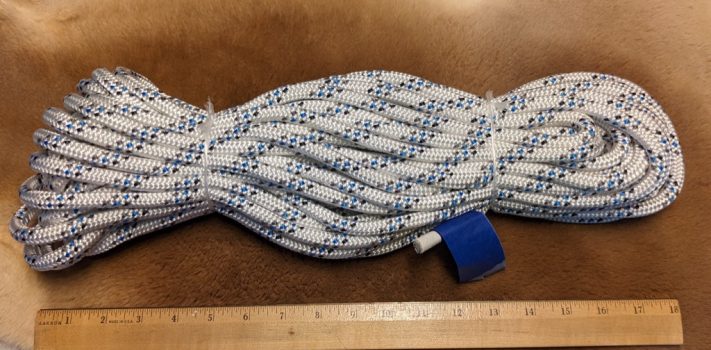One of my heroes is the late American humorist and outdoorsman Patrick F. McManus. Among Mr. McManus’ vast treasury of reflections about the human condition is a comment about rope. He wrote, “Give a man enough rope and it still will come out 6 inches too short. That is the nature of rope, if not the nature of man.” (“At Loose Ends”, in The Night the Bear Ate Goombaw.) I am happy to report that in one instance at least, the great Mr. McManus is not entirely correct.
I recently tested a 3/8 inch polyester double braid rope from Right Rope LLC of Saranac, Michigan. The rope was compact, strong, easy to tie, easy to untie, abrasion-resistant, and easy to handle without tangling. At approximately 78 feet in length, it was quite long enough for everything that I wanted to do with it. The rope effectively handles all the tasks for which I used it during the testing period without fail or strain. As an added benefit, the rope is made in the USA.
The 78-foot length that I tested was labeled as 75 feet in length and so priced at $39.75 at the time of this writing from RightRope.com. I highly recommend it.
Background
On July 28, 2024, a SurvivalBlog Contributor, Cactus Jack, had an entry in the non-fiction writing contest entitled “The Well-Rounded Prepper”. Among many other excellent points in that article, Cactus Jack mentioned the importance of a good supply of cordage. In that context, he wrote, “One of my favorites, since I’m a retired electrical worker, is ‘Muletape,’ or as the local home store calls it Polyester Electrical Cable Pull tape. Good for 2500 pounds and is as handy as a pocket for most any job requiring rope or cord. Stronger than paracord, flat, disposable and cheap.”
I was intrigued by this description, so I did an online search for “Muletape”. I found a lot of interesting varieties of electrical cable pull tape.
I also ran across some “Premium Polyester Double Braid Cable Pulling Rope” by Right Rope LLC. The 3/8 inch diameter rope has a tensile strength of 5,000 pounds. That sounded even more interesting than Muletape. So I contacted Right Rope to see if they could provide me with a sample for testing and evaluation.
Right Rope Customer Support was extremely helpful. We talked about the uses to which I would put the rope so that they could recommend the best rope for the job. I indicated that I was looking for a utility rope that someone could keep in the back of their pickup to tie down loads, to pull a bucket of tools up to a rooftop, to pull a fallen tree limb off the road, or for similar tasks. Right Rope indicated that a double-braid polyester would be great for those types of tasks, and discussed the various forms of double-braid polyester.
They also discussed breaking strength versus safe working load limits. For example, one of their 3/8 inch double braided polyester ropes has a breaking strength of 4,275 pounds but a recommended safe working load limit of 356-855 pounds.
At the conclusion of our discussion, they agreed to provide me with a sample for testing and evaluation. Just a few days later, a box arrived via USPS Ground Advantage from RightRope.com, 7235 Jordan Lake Road, Saranac, MI 48881-9763.
First Impressions
The shipping box measured 8.25 x 8.25 x 8 inches, and contained a beautiful length of 3/8 inch thick rope.
 I had previously had experience with 25 foot ropes proving to be six inches too short for tying down loads on a trailer. As a result, I asked for a sample that was at least 50 feet in length. Right Rope must also have had experiences with rope being six inches too short. As a result, the sample they provided was labeled as being 75 feet in length rather than just 50 feet. Whoever did the actual measuring must also have had experiences with rope being six inches too short. As a result, they threw in an extra yard of rope for good measure, giving me a total of 78 feet of rope.
I had previously had experience with 25 foot ropes proving to be six inches too short for tying down loads on a trailer. As a result, I asked for a sample that was at least 50 feet in length. Right Rope must also have had experiences with rope being six inches too short. As a result, the sample they provided was labeled as being 75 feet in length rather than just 50 feet. Whoever did the actual measuring must also have had experiences with rope being six inches too short. As a result, they threw in an extra yard of rope for good measure, giving me a total of 78 feet of rope.
I coiled the rope and put it in a nylon drawstring bag. This would help to keep the rope from getting tangled up with the trailer hitches, tow strap, jumper cables, ratchet strap, wiring harness, entrenching tool, and other items that I keep in the back of the truck.
Testing
Over the course of more than a month, I used the rope for a host of different tasks:

 Securing a ladder to the top of a trailer so that I could take it to my daughter’s house.
Securing a ladder to the top of a trailer so that I could take it to my daughter’s house.
Securing a chainsaw in the bed of the pickup so that the saw would not slide around while I was driving. I then delivered the saw to my friend’s house, since he was borrowing it. When doing a project like this that called for a fairly short section of rope, I left most of the rope in the drawstring bag, and just pulled out one end to use it for securing the saw.
Securing a gas can in the bed of the pickup so that it would not slide around while I was driving.

 Securing a ladder in the bed of the pickup so that I could take it home from my daughter’s house.
Securing a ladder in the bed of the pickup so that I could take it home from my daughter’s house.
attaching one end of the rope to a series of small trees that I was felling and the other end to the front tow point of my pickup. This enabled me to nudge each tree in the right direction by backing the truck up after the tree was properly notched and hinged.
 Raising and lowering the ends of a ladder from the place where I store the ladder under the rafters in the pole barn.
Raising and lowering the ends of a ladder from the place where I store the ladder under the rafters in the pole barn.
Securing the top of my ladder and the safety lanyard from my harness to a tree while trimming limbs from the tree.
The rope functioned consistently and reliably throughout the testing period.
More on McManus
As I began working on this review, I remembered that there was an outstanding Patrick F. McManua quote that I just had to include in my article.
I own ten volumes of his collected stories that form a treasured part of my personal library. A quick scan of the table of contents of each of those volumes did not reveal the story that I had in mind. Perhaps it was in one of the other seven volumes of his stories that I do not yet own? Or perhaps I had read the story in Outdoor Life or Field and Stream many decades ago when he was writing for those publications? The quote was so good that I just had to find it.
I did a search on DuckDuckGo.com for “patrick f mcmanus six inches too short.” That led me to www.outdoorlife.com. They had a quote from Mr. McManus’ September 1987 story “Tying One On.” I knew that the quote was from the story that I was looking for.
I then ran across the McManus Index web page. Mr. Lauren Ball, a fellow Patrick F. McManus afficionado, has devoted considerable effort to indexing all of the stories included in the volumes of Mr. McManus’ collected works and showing where they are found. I looked in the complete alphabetized list of all of the stories on his site, but I could not find any reference to “Tying One On.”
Finally, in desperation, I purchased Mr. Ball’s book Where’s the One About the Bobcat? An Index and Summaries of Patrick F. McManus’ Stories. When the book arrived, I looked up “rope” in the topical index and found out that Mr. McManus had written about rope in a story entitled “At Loose Ends”. I then turned to the summary of that story in the alphabetically arranged “Story Summaries” section of the book. There I discovered that “At Loose Ends” is included in the volume of collected stories entitled The Night the Bear Ate Goombaw.
I have that volume, so I turned to its table of contents, and found that “At Loose Ends” began on page 36 of that collection. It was the story I was looking for. It was not listed in the index as “Tying One On” because many of the original titles were changed when the stories were collected into the volume.
And that brings me (finally) to the Pat McManus quote that I was so fervently seeking:
“A real rope looks like this: The first two feet consist of an unraveled portion of hemp leading up to a big knot whose purpose is to stop the unraveling. The hemp section, approximately one inch in diameter, contains three other permanent knots of unknown or forgotten function and a permanent loop about the size of a dinner plate. Tied onto the hemp section is a length of semirotten clothesline. This in turn joins a stiff blue nylon water-skiing rope, with the handgrip still attached. The water-skiing section is tied to a length of twine, which serves as the terminal or tie-down end. This is the rope you use to tie a twelve-hundred-dollar canoe to the top of your car. It is six inches too short.”
The other day, I removed a bag from the back of my truck. I did not need the contents of that bag anymore now that the Right Rope was in the truck. I won’t embarrass myself by describing the contents of the bag that I removed. I will merely note that Mr. McManus was a remarkably perceptive man.
Conclusions
Right Rope 3/8 inch polyester double braid rope makes a good utility rope for the back of a pickup. It is tough, attractive, abrasion-resistant, strong, and reasonably compact. I highly recommend it.
Disclaimer
Right Rope LLC provided me with a sample of their 3/8 inch polyester double braid rope for testing and evaluation. I tried not to allow their kindness to interfere with my objectivity, and I believe that I have succeeded. I did not receive any other financial or other inducement to mention any vendor, product, or service in this article.










